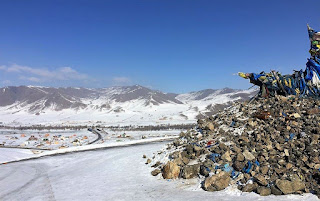PHIL: Day
15/1 March.
By
now we have decided we couldn’t stomach two days of this charade so, after
Allie watched cheetah and a leopard being served their breakfast, we fled into
Omaruru. Not, however, before chancing upon yet another balloonist based in Namibia
Omaruru
town gives an even stronger sense of ‘Germany Namibia
Daytime
diversions include a nicely preserved war memorial commemorating German victory
over the local Herero tribe in 1904, curiously (in PC Africa) proclaimed as a
Namibian Heritage Site. A German here also runs the only winery in Namibia
 |
| Omaruru church |
Dinner
menu at the Central is straight out of Bavaria
ALLIE: DAY 15: Thursday, 1st of March
Fighting the
internet, a deserted airstrip, a winery and a chocolate factory
We decided that we wanted to escape from the zoo. But at
least I want to see the leopard and the cheetahs. They are fed each morning
with a bit bloody piece of Kudu meat. Within seconds they dig into the meat
groaning and purring like real cats. But you wouldn’t want to mess with them.
The leopard has already killed two females that we supposed to mate with him!
Even trying to take a picture of him seems to be out of discussion with him. We
leave.
Book ourselves into the much cheaper and friendly German run “Central Hotel” in central Omaruru and battle with the non-existing internet connection at the local Telecom shop. The national agency itself has to ring up Windhoek headquarters and book a line to get access, incredible!
In the afternoon we search for the remains of the “Runway
Pub” and the local flying club, but all we can find – again to the great
disappointment of Phil – are three dogs and a closed hangar. The public swimming pool or the local golf
course are also devoid from any signs of activity. It seems to me that the 500
Germans and 2500 blacks are mainly interested in their huge department store
“Spar” and possibly in religious affairs. I count at least five churches from
different denominations.
To console my husband we drive to the “Kristall Kellerei”, a
winery. A grumpy looking and very reserved man stands behind a bar and doesn’t
say anything. So we shyly ask for a wine tasting. He pulls out a bottle of
white, a red and then some Schnaps. We especially like his “cactus Schnaps” and
end up in buying two bottles of the digestive. Very tasty indeed. Maybe even to
nice to give away as presents…
For 17 years he has been living here running a plumbing business on this farm. The he got the idea of producing wine. He tried and succeeded. His Merlot, Cabernet Sauvignon and other grapes turn nicely into good tasting wines under the hot sun of Africa. The problem with too little rain is solved by watering systems from the ground.
For 17 years he has been living here running a plumbing business on this farm. The he got the idea of producing wine. He tried and succeeded. His Merlot, Cabernet Sauvignon and other grapes turn nicely into good tasting wines under the hot sun of Africa. The problem with too little rain is solved by watering systems from the ground.
After the alcohol, we need some food. So we visit the
chocolate factory. How anybody in the world can make a profit of producing
chocolate in a hot desert country like this? But the Urte and Kallie Doergeloh
do. “We are busy all year round,” she explains to us whilst we taste some of
her delicious hand made pralines. And then she shows us her “production line”.
They consist of exactly three persons: one who oversees the ovens where the
chocolate is melted, the next one pours the hot melted Belgium chocolate into a
mould whilst the third one wraps each single praline into a piece of coloured
paper. Not daring to buy chocolate in this 38 degree heat we decide that we can
at least buy some of her side products: foot cream for “dry and smelly feet”!

























